News
- sales sales on "whats in your horses mouth?" ~ article by amy mclean
- sales sales on "whats in your horses mouth?" ~ article by amy mclean
- debbie on "whats in your horses mouth?" ~ article by amy mclean
- kent taylor on "whats in your horses mouth?" ~ article by amy mclean
- red bottoms shoes for women on welcome to our new blog!
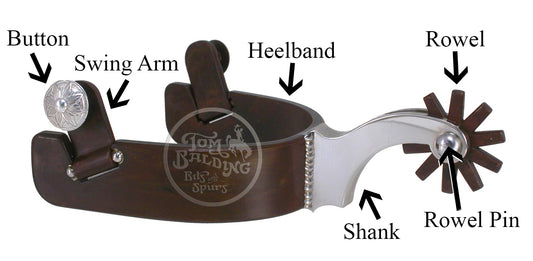
Anatomy of a spur
Button:Â This is the part the slips into the spur straps to hold them on the spur. Swing Arm:Â The swing arm hold the button to the heelband and, if hinged, allows for some movement. Bronc spurs typically have the spur bottom directly on the heelband and do not have a swing arm. Heelband:Â The heelband is the part the slides onto the back of your boot. It is sized to fit the rider and can be made of different weighted material for different preferences. Overlays can be placed on this part of the spur to dress it up. Other terms for this part of the spur are 'Yoke' or 'Branch'. Shank:Â The shank is the contact between the heelband and rowel. It is offered in many different lengths and angles to ensure the rider is able to use their spurs to the best of their ability. Overlays are also often placed on this part of the spurs. This part is also sometimes referred to as the 'Neck' of the spur. Rowel Pin:Â As the name suggests, this is the pin that holds the rowel onto the shank. It can be attached in many ways with the most common being to weld the end of...
Read MoreAnatomy of a spur
Button:Â This is the part the slips into the spur straps to hold them on the spur. Swing Arm:Â The swing arm hold the button to the heelband and, if hinged, allows for some movement. Bronc spurs typically have the spur bottom directly on the heelband and do not have a swing arm. Heelband:Â The heelband is the part the slides onto the back of your boot. It is sized to fit the rider and can be made of different weighted material for different preferences. Overlays can be placed on this part of the spur to dress it up. Other terms for this part of the spur are 'Yoke' or 'Branch'. Shank:Â The shank is the contact between the heelband and rowel. It is offered in many different lengths and angles to ensure the rider is able to use their spurs to the best of their ability. Overlays are also often placed on this part of the spurs. This part is also sometimes referred to as the 'Neck' of the spur. Rowel Pin:Â As the name suggests, this is the pin that holds the rowel onto the shank. It can be attached in many ways with the most common being to weld the end of...
Read More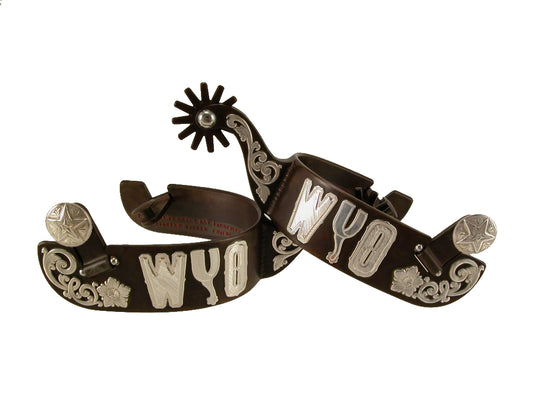
A History of Sheridan WYO Rodeo
One of the biggest events to hit Sheridan every year is the Sheridan WYO Rodeo! The upcoming dates are, July 11th - 17th, 2016. A History, by Tom Ringley (sited from sheridanwyorodeo.com) In 1931, the small town of Sheridan, Wyoming, was so quiet you could shoot a shotgun down Main Street and have no fear of injuring anyone. A group of local citizens wanted to do something about the situation and decided to put on a rodeo. They set their sights high and organized a first-class professional rodeo on a par with other professional rodeos like the Cheyenne Frontier Days in Cheyenne, Wyoming. The committee started out from ground zero and had a huge challenge. Not only did the rodeo committee have to organize the rodeo from scratch, but they also had to prepare the county fairgrounds facility that lacked the necessary amenities for a large professional rodeo. They sold capital stock to finance the construction of additional seating, corrals, pens, and bucking chutes among other things. To publicize the event, E. W. Bill Gollings was commissioned to paint a picture for the first Sheridan-Wyo-Rodeo poster. The entire community and downtown merchants helped support the efforts of the rodeo committee to...
Read MoreA History of Sheridan WYO Rodeo
One of the biggest events to hit Sheridan every year is the Sheridan WYO Rodeo! The upcoming dates are, July 11th - 17th, 2016. A History, by Tom Ringley (sited from sheridanwyorodeo.com) In 1931, the small town of Sheridan, Wyoming, was so quiet you could shoot a shotgun down Main Street and have no fear of injuring anyone. A group of local citizens wanted to do something about the situation and decided to put on a rodeo. They set their sights high and organized a first-class professional rodeo on a par with other professional rodeos like the Cheyenne Frontier Days in Cheyenne, Wyoming. The committee started out from ground zero and had a huge challenge. Not only did the rodeo committee have to organize the rodeo from scratch, but they also had to prepare the county fairgrounds facility that lacked the necessary amenities for a large professional rodeo. They sold capital stock to finance the construction of additional seating, corrals, pens, and bucking chutes among other things. To publicize the event, E. W. Bill Gollings was commissioned to paint a picture for the first Sheridan-Wyo-Rodeo poster. The entire community and downtown merchants helped support the efforts of the rodeo committee to...
Read More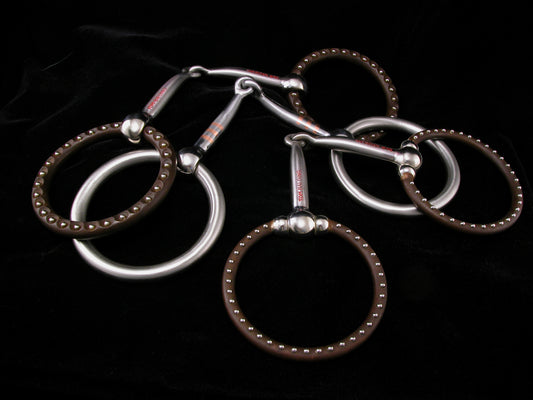
A Bit of Advice from Gina Miles
A Bit of Advice from Gina Miles Olympic three-day eventer Gina Miles shares 10 tips for selecting an appropriate bit. By Holly Caccamise | December 2013 - This article originally appeared in the August 2011 issue of Horse Illustrated. Illustrated. Click here to subscribe. Selecting the correct bit is one of the most important parts of training your horse and bringing out his best performance. Here, Gina Miles, the 2008 Olympic individual silver medalist in three-day eventing, shares advice to help you navigate the many bits out there. Miles uses the following guidelines when deciding on a bit for a particular horse-and-rider combination. Use the simplest bit for the job. "Whenever I have a new horse in the barn or a new student, I first want to see how they go in a very basic double-jointed loose-ring snaffle, a says Miles. Always remember to go back to the basics. If you have been using other bits during show season, try going back to the basic double-jointed snaffle during a break from competition or over the winter. "It’s always a good idea to take a step back and see if your training has been effective and produced a more rideable, responsive horse” says Miles. Use enough noseband to...
Read MoreA Bit of Advice from Gina Miles
A Bit of Advice from Gina Miles Olympic three-day eventer Gina Miles shares 10 tips for selecting an appropriate bit. By Holly Caccamise | December 2013 - This article originally appeared in the August 2011 issue of Horse Illustrated. Illustrated. Click here to subscribe. Selecting the correct bit is one of the most important parts of training your horse and bringing out his best performance. Here, Gina Miles, the 2008 Olympic individual silver medalist in three-day eventing, shares advice to help you navigate the many bits out there. Miles uses the following guidelines when deciding on a bit for a particular horse-and-rider combination. Use the simplest bit for the job. "Whenever I have a new horse in the barn or a new student, I first want to see how they go in a very basic double-jointed loose-ring snaffle, a says Miles. Always remember to go back to the basics. If you have been using other bits during show season, try going back to the basic double-jointed snaffle during a break from competition or over the winter. "It’s always a good idea to take a step back and see if your training has been effective and produced a more rideable, responsive horse” says Miles. Use enough noseband to...
Read More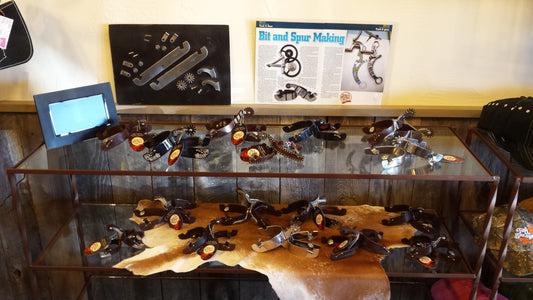
KEEPING YOU IN BITS AND SPUR
KEEPING YOU IN BITS AND SPURS Have you bits or spurs by this weekend! We try to keep a moderate stock that is ready to ship out today! If you are looking for a particular combination we might have it already built up. The stock in our gift shop is always changing with purchases and new builds. To see if we have what you want in stock please call 307-672-8459 or email sales@tombalding.com. Thanks!
Read MoreKEEPING YOU IN BITS AND SPUR
KEEPING YOU IN BITS AND SPURS Have you bits or spurs by this weekend! We try to keep a moderate stock that is ready to ship out today! If you are looking for a particular combination we might have it already built up. The stock in our gift shop is always changing with purchases and new builds. To see if we have what you want in stock please call 307-672-8459 or email sales@tombalding.com. Thanks!
Read MoreA NOTE FROM THE TOM BALDING BITS & SPURS FAMILY
A NOTE FROM THE TOM BALDING BITS & SPURS FAMILY Being part of the Tom Balding Bits & Spurs team is being part of a family. You feel loved and valued from the moment you walk in the door and are greeted with smiles, to the moment you are sent off for the day with well wishes for a good evening. Personal hardships are surrounded with support and personal accomplishments are celebrated. Each member of the team shares Tom's passion for the outdoors, family, community, and personal growth. The office and shop are not open over holidays or weekends, but instead the time is encouraged towards exploring the world, growing personal hobbies, and being with family and friends. We invite you to learn more about each team member on our 'meet the staff' page. As a customer you are highly valued and always treated with the utmost kindness, respect, and quality craftsmanship. Without you each of us would not be able to be a part of the Tom Balding Bits & Spurs family. We are all very grateful for the continued support as we look ahead to 2016! From our families to yours, we genuinely wish you a Holiday season filled with...
Read MoreA NOTE FROM THE TOM BALDING BITS & SPURS FAMILY
A NOTE FROM THE TOM BALDING BITS & SPURS FAMILY Being part of the Tom Balding Bits & Spurs team is being part of a family. You feel loved and valued from the moment you walk in the door and are greeted with smiles, to the moment you are sent off for the day with well wishes for a good evening. Personal hardships are surrounded with support and personal accomplishments are celebrated. Each member of the team shares Tom's passion for the outdoors, family, community, and personal growth. The office and shop are not open over holidays or weekends, but instead the time is encouraged towards exploring the world, growing personal hobbies, and being with family and friends. We invite you to learn more about each team member on our 'meet the staff' page. As a customer you are highly valued and always treated with the utmost kindness, respect, and quality craftsmanship. Without you each of us would not be able to be a part of the Tom Balding Bits & Spurs family. We are all very grateful for the continued support as we look ahead to 2016! From our families to yours, we genuinely wish you a Holiday season filled with...
Read MoreWHAT WE'RE MADE OF
What we're made of Understanding the materials used in your horse's bits When we put something in our mouth it has a distinctive flavor and creates a reaction in us. We might spit it out, find it somewhat bland, or savor the flavor as long as possible. Your horse's mouth also reacts to a mouthpiece's different materials. Below is a quick and dirty list of materials used in bit mouthpieces and how they effect your horse. Please keep in mind that these are statements based on the majority and do not always apply to all horses. Just like you have (or are) that strange friend who likes to eat a lemon like an apple.... your horse could have unique tastes. Our mouthpieces are made of sweet iron and copper, as these two materials are easily accepted by most horses.  Sweet Iron: Sweet iron is a mild steel that tends to rust over time. Rust on a mouthpiece is a good thing as it tends to increase a horse's salivation; much a like a piece of candy would in your mouth.  Copper: Copper offers a sweet taste that horses enjoy. It is better at increasing salivation than sweet iron; allowing an ease in acceptance. Copper is often formed into...
Read MoreWHAT WE'RE MADE OF
What we're made of Understanding the materials used in your horse's bits When we put something in our mouth it has a distinctive flavor and creates a reaction in us. We might spit it out, find it somewhat bland, or savor the flavor as long as possible. Your horse's mouth also reacts to a mouthpiece's different materials. Below is a quick and dirty list of materials used in bit mouthpieces and how they effect your horse. Please keep in mind that these are statements based on the majority and do not always apply to all horses. Just like you have (or are) that strange friend who likes to eat a lemon like an apple.... your horse could have unique tastes. Our mouthpieces are made of sweet iron and copper, as these two materials are easily accepted by most horses.  Sweet Iron: Sweet iron is a mild steel that tends to rust over time. Rust on a mouthpiece is a good thing as it tends to increase a horse's salivation; much a like a piece of candy would in your mouth.  Copper: Copper offers a sweet taste that horses enjoy. It is better at increasing salivation than sweet iron; allowing an ease in acceptance. Copper is often formed into...
Read MoreNot in a pinch...
Not in a pinch... What it means when "non pinching" mouthpieces and bits are termed We have all heard it...."this bit is non pinching", "this is a pinch proof design", "pinchless designs are the only way to go", etc. What exactly are they saying? Lets look at this from a different angle. What is a pinching bit? A pinching bit is one that allows a horse's lip or cheek to get between moving parts, creating a "pinch". This can be very painful and cause negative behaviors in the horse.... can you blame the horse? A non pinching, pinch proof, or pinchless design would be one that does not allow for the space to get a lip or cheek in. To accomplish this a maker will need well thought out designs and precision execution of the builds. Quality material and craftsmanship should not wallow out, eliminating wear and spacing issues. Can anyone claim to have created a 100% pinch proof bit with moving parts? No. Our designs are non pinching; however, hinging parts that are used incorrectly can fold in on themselves enough to cause discomfort. Think of a hinged door; it is possible to pinch your finger in between the door and...
Read MoreNot in a pinch...
Not in a pinch... What it means when "non pinching" mouthpieces and bits are termed We have all heard it...."this bit is non pinching", "this is a pinch proof design", "pinchless designs are the only way to go", etc. What exactly are they saying? Lets look at this from a different angle. What is a pinching bit? A pinching bit is one that allows a horse's lip or cheek to get between moving parts, creating a "pinch". This can be very painful and cause negative behaviors in the horse.... can you blame the horse? A non pinching, pinch proof, or pinchless design would be one that does not allow for the space to get a lip or cheek in. To accomplish this a maker will need well thought out designs and precision execution of the builds. Quality material and craftsmanship should not wallow out, eliminating wear and spacing issues. Can anyone claim to have created a 100% pinch proof bit with moving parts? No. Our designs are non pinching; however, hinging parts that are used incorrectly can fold in on themselves enough to cause discomfort. Think of a hinged door; it is possible to pinch your finger in between the door and...
Read More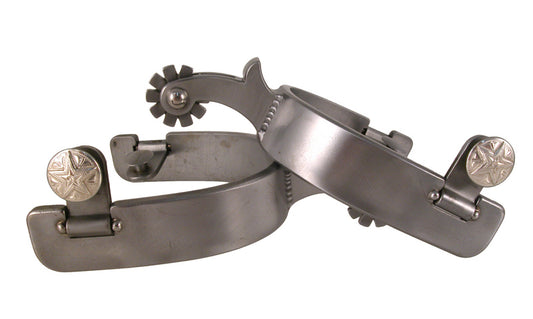
Billy Klapper Style
Billy Klapper Style How Billy Klapper has influenced Tom's bit and spur designs. A little backgound on Billy Klapper: He trained with early spur masters such as Adolph Bayers and has spent his life perfecting the trade. He has over 680 patterns, but accommodates his customers wishes for custom designs. His first designs do not have his makers mark stamped in them. This was a process he started in 1966 by marking each with his name and a serial number. Based in Pampa Texas, he builds each spur from a solid piece of metal using a small coal forge. He is a one man operation and can turn out two hundred pair a year with a waiting list spanning well over a year. In an attempt to learn early on from the masters; Tom spent time visiting Billy Klappers workshop and discussing the processes he used. Billy Klapper spoke freely and took time to teach different techniques to Tom. The respect Tom has for Billy Klapper can be seen in his applications of the lessons learned. It is most evident in his Texas Style spur heelbands, spur shank 102 and 546, as well as the Klapper bit mouthpiece. When...
Read MoreBilly Klapper Style
Billy Klapper Style How Billy Klapper has influenced Tom's bit and spur designs. A little backgound on Billy Klapper: He trained with early spur masters such as Adolph Bayers and has spent his life perfecting the trade. He has over 680 patterns, but accommodates his customers wishes for custom designs. His first designs do not have his makers mark stamped in them. This was a process he started in 1966 by marking each with his name and a serial number. Based in Pampa Texas, he builds each spur from a solid piece of metal using a small coal forge. He is a one man operation and can turn out two hundred pair a year with a waiting list spanning well over a year. In an attempt to learn early on from the masters; Tom spent time visiting Billy Klappers workshop and discussing the processes he used. Billy Klapper spoke freely and took time to teach different techniques to Tom. The respect Tom has for Billy Klapper can be seen in his applications of the lessons learned. It is most evident in his Texas Style spur heelbands, spur shank 102 and 546, as well as the Klapper bit mouthpiece. When...
Read More